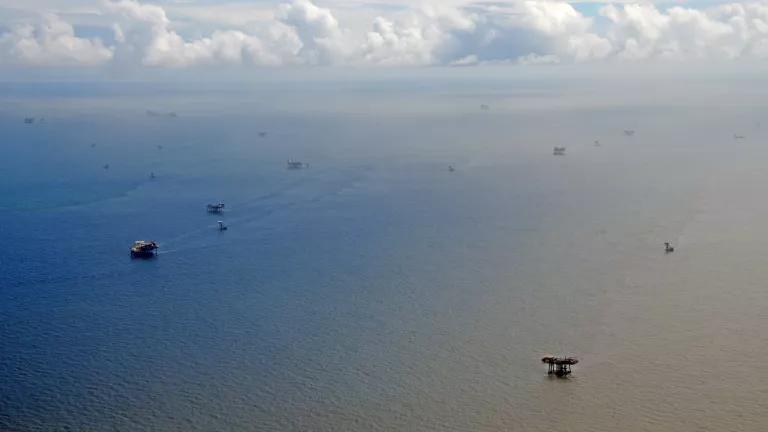The Trump administration plans to slash the National Oceanic and Atmospheric Administration’s (NOAA) budget by 17 percent, targeting programs that are crucial to America’s economy and public health and safety, according to a Washington Post report.
The leaked OMB document obtained by the Post reportedly shows that the Trump administration will slash funding for NOAA’s Office of Oceanic and Atmospheric Research and its satellite data division by a devastating 26 and 22 percent, respectively. Other programs would be cut entirely, including those that assist states in managing their coastal zones and build community resilience to sea level rise and other environmental changes, that protect estuary reserves, and that support coastal states to create new jobs and address threats to our oceans and coasts.
The National Weather Service and the National Marine Fisheries Service would suffer 5 percent cuts. While the direct cuts to these offices are smaller, they mask the harm to these programs from the more sweeping budget cuts. Satellite data and information are essential to produce the data that the forecasts and warnings provided by the National Weather Service rely on. Likewise, the National Marine Fisheries Service depends on NOAA satellite information to steward our ocean resources, providing for sustainable fisheries, safe sources of seafood, and healthy ocean ecosystems.
Housed within the Department of Commerce, the agency charged with overseeing the nation’s economic growth and job creation, NOAA provides crucial safety and environmental information to help communities and businesses prepare for risks and prosper. NOAA’s products—such as daily weather forecasts, severe storm warnings and flood forecasts—and services—like restoring failing coastlines to protect communities and managing our nation’s ocean fisheries—affect more than one-third of America’s gross domestic production.
Cuts to NOAA’s essential products and services would undermine the safety of communities across the nation—coastal and inland—and disadvantage important sectors of the American economy. Anyone who relies on accurate weather and climate forecasting, including farmers, fisherman, mariners, pilots, not to mention anyone in the path of a severe storm, stands to be impacted by the proposed cuts.
The programs most at risk by the proposed cuts provide critical services that many states and citizens rely on.
The Office of Oceanic and Atmospheric Research (OAR), whose budget could be reduced by more than one-quarter, provides the research foundation for many of NOAA’s programs. It focuses on enabling better forecasts, and earlier warnings for natural disasters. Offices within OAR that will or could be affected include:
- The Climate Program Office helps communities, businesses and citizens prepare for drought and water shortages, manage risks to our coasts and coastal communities, and reduce vulnerability to weather-related disasters that claim lives and money.
- The Office of Weather and Air Quality improves forecasts related to hurricanes, floods, destructive fire events, and helps vulnerable adults and children avoid harmful air pollution.
- NOAA Sea Grant, singled out for elimination, is a federal-private partnership that uses science, outreach and education to positively impact coastal communities. The Sea Grant program creates or retains over 20,000 jobs and nearly 3,000 businesses annually. University-based Sea Grant programs are found in every coastal and Great lakes state, plus Puerto Rico and Guam.
- The Ocean Acidification Program, which tracks changes in ocean chemistry, provides early warnings and investment information to help fisherman and aquaculture owners avoid or prepare for risks. For example, this program funded the development of early warning systems to help oyster growers from losing their oyster stocks to rising ocean acidification. The shellfish industry in the Pacific Northwest alone is a $270 million/year industry employing thousands of people and producing ¼ of all U.S. oysters.
- The Office of Ocean Exploration and Research, which explores our relatively unknown oceans. Recent expeditions included mapping the deep Atlantic canyons off America’s eastern seaboard, unlocking the secrets of the extraordinary universe of life that exists deep below the waves.
NOAA’s satellite division (the National Environmental Satellite, Data, and Information Service or NESDIS) launches and operates satellites, and manages the product development and distribution of data transmitted by those NOAA satellites. Data and information from NOAA’s satellites serve the nation by enabling accurate weather forecasts and warnings, predictions of environmental trends such as drought, air quality from wildland fires, and harmful algal blooms, and safe operation of ships and aircraft. Data from NOAA satellites are used by the Defense Department to keep Americans safe at home and abroad, and by search and rescue teams who have saved over 39,000 boaters, aviators and others since 1982. Slashing funding for NOAA’s satellite division would cripple these activities, weakening American readiness and needlessly putting lives at risk.
Two additional programs purportedly on the chopping block include:
- NOAA’s Coastal Zone Management Program, which helps keeps coastal residents safe, the economy sound, and waters protected. This program provides essential funding to coastal states to address some of today’s most pressing issues, including coastal development, water quality, beach quality and access, and the siting of energy facilities. States have wide leverage to apply this funding in ways that will most benefit its communities and businesses.
- The Coastal Resilience Grant Program, which helps states, territories, tribes and local government protect life and property, strengthen their economy and conserve coastal and marine resources by reducing risks associated from extreme weather events. Projects funded in the last cycle helped to protect coastlines in states around the nation from sea level rise, and helped floodplain managers find effective techniques to build resilient community buildings and infrastructure.
NOAA is key to providing our nation with the cutting-edge research, life-saving data and information, and insights that are crucial to enabling our communities and businesses to prosper. NOAA protects our communities, helps conserve precious ocean resources and plays a critical role in predicting and preparing for extreme weather. Leaving our states and communities without this vital information and assistance is a shortsighted and dangerous strategy.




